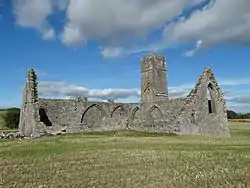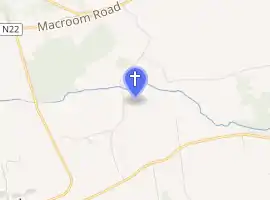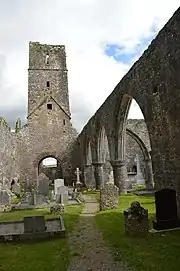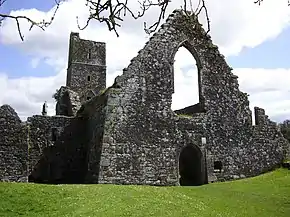Kilcrea Friary
Kilcrea Friary (Irish: Prióireacht Chill Chré)[1] is a ruined medieval abbey located near Ovens, County Cork, Ireland. Both the friary and Kilcrea Castle, located in ruin to the west, were built by Observant Franciscans in the mid 15th century[2] under the invitation of Cormac Láidir MacCarthy, Lord of Muskerry, as protection from English troops.
| Kilcrea Friary | |
|---|---|
Prióireacht Chill Chré | |
 Kilcrea Friary | |

| |
| Location | Ovens, County Cork |
| Country | Ireland |
| Denomination | Catholic Church |
| History | |
| Status | Ruined |
| Founded | 1463 or 1465 |
| Architecture | |
| Functional status | Friary |
The friary was sacked by the English army a number of times in the late 1500s, during which it sustained considerable damage, but remained occupied by friars until the 1620s. MacCarthy was killed in battle in 1494 and is buried at the site.[3] The site has remained in continuous use as a burial ground,[4] and contains, among others, the remains Art Ó Laoghaire, who was the subject of an epic poem written by Eibhlín Dubh Ní Chonaill.
The abbey's main features include an aisle, a transept on the south-side, and cloisters at the north end. The narrow tower is ascended via a series of steep and winding stairs. The areas around the tower were once dormitories, day rooms and kitchens.
The name Kilcrea (Irish: Cill Chré) is derived from the Irish Cill Chre (Cell of Cyra).[5] St Créidh (anglicised as Saint Cyra) lived in the 6th century and is said to have founded a nunnery about a mile east of the friary, in the parish of St Owen's, today known as Ovens.
History

The abbey was founded in 1465 for the Observant Franciscans by Cormac Láidir MacCarthy, Lord of Muskerry,[6] on the grounds of on an earlier Christian site. Located in the valley of the Bride river,[7] it is named after the sixth-century holy lady Saint Cyra, said to have been the abbess of the original nunnery located on the site,[8] and who by legend may be interred in the centre of the choir. Although both the abbey and nearby Kilcrea Castle are located in what is today open countryside, it is thought that originally the sites were positioned on an east–west axis of a now-abandoned early medieval settlement.[9]
Kilcrea was first attacked by the English army in 1542 and sacked in 1584, but continued in use under MacCarthy's patronage.[10] In 1597, it was granted to Cormac MacDermot MacCarthy. It was twice repaired, including in 1604, and remained active until the 1620s, with Fr. John Gould recorded as Superior in 1621.[10][11]
Its grounds have been used for general burial since the early 17th century; mostly in the graveyard within the ruins of the abbey's chancel.[10] It was the burial place of the McCarthy's of Muskerry from 1494 to 1616, commencing. with Cormac MacCarthy. However, there are no surviving traces of their tombs on the site. Cormac Láidir MacCarthy tomb bears the inscription: "Hit Jacet Cormac filius Derm-ittu Magni MlcCarthy, Domii nus de Illutsgraiyli IFlayn, at istius conventus prinius fun dator An. Dont. 1495".[12] A head carved on the tower's upper floors is thought to represent him.[13]
Architecture and layout

Kilcrea Friary consists of a series of buildings located around a main church or chapel. Although in ruins, the abbey is still relatively complete, including its tower, cloister and the surrounding east, west and north-facing buildings. The abbey's chapel contains a nave, chancel, transept and an L-shaped aisle.[10] It is entered through a doorway in its west gable. An arcade separates the nave from the south aisle and transept. The chancel contains a large window on its east wall, which has lost its original intersecting tracery. The other four pointed windows are fixed on the south wall via segmental-headed embrasures, and contained either single or twined glass panes (lights).[10] No trace survives of the high altar which was likely positioned under the east window, but an arched piscina is found nearby in the south wall. Adjoining the chancel is the sacristy which was added in the 16th century, above which is the scriptorium.[10]
_-_geograph.org.uk_-_1392092.jpg.webp)
The cloister area is located north of the church. The arcades are missing from the cloister, although the roofless two-story ranges are well preserved and mostly intact.[10] The remains of the chapter room and refectory or possibly the kitchen (33 x 21 ft)[14] are located on the east range,[15] above which are the dormitories.[10] There is evidence in some records that the friary once contained an infirmary, however the precise room has not been identified.[16]
The scriptorium measures 39 x 17 ft and probably also functioned as a study-room. As with all such rooms in medieval Irish friaries, it was the most well lite room on the site; the room in Kilcrea contains 11 tall two-light windows.[17]
A recess for a holy water stoup is located outside the doorway, and in the gable over the doorway are the remains of a large, three-light window.
The tower contained four storeys with timber floors supported on stone corbels. Each storey was lit by plain, narrow, flat-headed windows. Except for the top storey where there is a single ogee-headed light in each wall. It is broader at its base in order to accommodate the stairways and passage to the tower.[18]
A 15th-century manuscript written at Kilcrea is preserved in Rennes, France.[19]
Notable burials
- Cormac Laidir MacCarthy (1411–1494), 6th Lord of Muskerry[20]
- Thomas O'Herlahy, Catholic Bishop of Ross (1561–1579)[21]
- Art Ó Laoghaire (1746–1773), subject of the poem "Caoineadh Airt Uí Laoghaire[22]
References
Notes
- Irish Placenames Commission.
- O'Neil 2014, p. 7.
- Measom 1870, p. 381.
- Noonan 2001, p. 86.
- Arnold 1967, p. 463.
- Power 1997, p. 86.
- Kelly 1918, p. 522.
- Irish Rivers 1848, p. 702.
- Keohane 2020, p. 451.
- Keohane 2020, p. 452.
- O'Connell 1939, p. 39.
- Kelly 1918, p. 523.
- Cork County Council 2017, p. 159.
- Mooney 1957, p. 24.
- Mooney 1957, p. 25.
- Mooney 1957, p. 31.
- Mooney 1957, p. 28.
- Mooney 1957, p. 7.
- Irish Ecclesiastical Record 1942, p. 218.
- Monastic Ireland.
- Catholic Answers.
- Bateson 2004, p. 153.
Sources
- Arnold, Matthew (1967). "Franciscan reorganisation in Munster during the early seventeenth century". Study of Celtic Literature (Irish History & Culture). NY: Port Washington: Imprint unknown. 15.
- Bateson, Ray (2004). The End: An Illustrated Guide to the Graves of Irish Writers. Irish Graves Publications. ISBN 978-0-9542-2751-7.
- Cork County Council (2017). Heritage Castles of County Cork. Cork: Heritage Unit of Cork County Council. ISBN 978-0-9935-9693-3.
- Kelly, Thomas (1918). "The Franciscan Friary of Kilcrea". TThe Irish Monthly. 543. Dublin: Irish Jesuit Province. 46.
- Keohane, Frank (2020). Cork: City and County (Buildings of Ireland series). New Haven and London: Yale University Press. ISBN 978-0-300-22487-0.
- Noonan, Damien (2001). Castles and Ancient Monuments in Ireland. Arum Press. ISBN 1-8541-0752-6.
- Measom, George (1870). Illustrated Guide Great Southern Western Railway. C. Griffin & Company. p. 381.
- Millett, Benignus (1964). The Irish Franciscans, 1651-1665. Gregorian & Biblical Press. ISBN 978-8-8765-2102-7.
- Mooney, Canice (1957). "Franciscan Architecture in Pre-Reformation Ireland (Part III)". The Journal of the Royal Society of Antiquaries of Ireland. 87. Dublin: Royal Society of Antiquaries of Ireland. 1.
- O'Connell, W. D. (1939). "Franciscan reorganisation in Munster during the early seventeenth century" (PDF). Journal of the Cork Historical and Archaeological Society. II. Cork: Guy & Company. 44 (159).
- O'Neil, Timothy (2014). The Irish Hand: Scribes and Their Manuscripts from the Earliest Times to the Seventeenth Century. Cork: Cork University Press.
- Power, Denis (1997). Archaeological Inventory of County Cork Vol. III. Cork City Council. ISBN 978-0-7076-0175-5.
- "Prióireacht Chill Chré / Kilcrea Friary". Irish Placenames Commission, Department of Culture, Heritage and the Gaeltacht. Retrieved 19 February 2020.
- "Irish Rivers; No. VI - The Lee". The University Magazine: A Literary and Philosophic Review. James McGlashan. 31 (181). 1848.
- "Series 5, Volume 60". The Irish Ecclesiastical Record. Dublin: Browne and Nolan. 1942.
- "Kilcrea Franciscan Friary". Monastic Ireland. The Discovery Programme. Retrieved 12 July 2020.
- "Thomas O'Herlahy, Bishop of Ross, Ireland, d. 1579". catholic.com. Catholic Answers. Retrieved 11 July 2020.
External links
| Wikimedia Commons has media related to Kilcrea Friary. |